The Tijaniyya Tariqa stands out as one of the most influential Sufi orders in the Islamic world, particularly known for its large presence in West Africa. Founded in the late 18th century by Ahmad al-Tijani, the order has expanded its influence across continents. The tariqa plays a pivotal role in the religious and social lives of millions.
Sufism is centered on Islam’s spiritual aspects, seeking a deep connection with Allah (God) through actions which purify the heart. It is often guided by mystical leaders known as shaykhs or saints, who lead a tariqa (meaning a path or brotherhood). The Tijaniyya is one of many sufi tariqas.
This blog post explores the origins, practices and key figures of the Tijaniyya, then focuses on its impact on followers.
Who founded the Tijaniyya Tariqa?
The Tijaniyya Tariqa was initiated by Ahmad al-Tijani (1737-1815) in Fez, Morocco. Born in Algeria, Al-Tijani kicked off his exploration of Sufism at the age of 21. He traveled throughout the Muslim world, was taught by established sufi saints and joined many existing Sufi orders like the Qadiriyya and Nasiriyya tariqas.
In 1782, Ahmad al-Tijani stated Prophet Muhammad (ﷺ) appeared to him in a vision, instructing him to establish a new spiritual path. The special prayers and practices (wird) were then shared and hence the Tijaniyya tariqa was born.
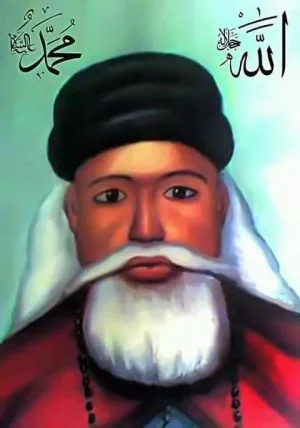
Portrait of Ahmed Al-Tijani. Source: MedinaCheikh Tidjani
In 1789, Ahmad al-Tijani returned from his travels back to Fez to establish the new tariqa. Initially, he experienced resistance from local religious leaders and communities of other Sufi tariqas. This was largely because all followers (called disciples) must leave other sufi paths, and exclusively commit to Tijaniyya teachings. Despite challenges, Al-Tijani built his “Zawiya of Sidi Ahmed al-Tijani” in Fez, with the support of the Moroccan Sultan.
A zawiya (meaning ‘corner’) is a building and community in Islamic Sufi culture, that serves as a meeting place for spiritual practices, education and social services.
So the Tijaniyya order quickly began to attract a significant following and flourished throughout northern africa.
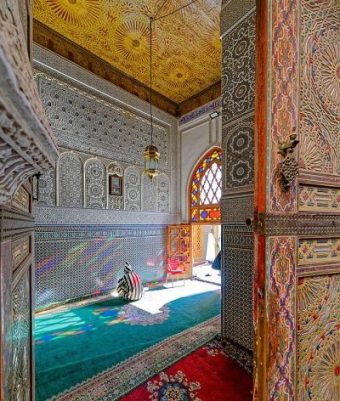
Zawiya of Sidi Ahmed al-Tijani in Fez, Morocco. Source Wikimedia Commons

Mausoleum of Sidi Ahmed al-Tijani in Fez, Morocco. Source Wikimedia Commons
Ahmad al-Tijani continued to grow his tariqa until his death in 1815, after which the brotherhood was split into sub-branches.
What are Tijaniyya Practices?
Tijani teachings guides its followers to pursue inner purification while maintaining moral integrity in everyday interactions. Some of the ways it does so are:
- Spiritual Hierarchy and Leadership: Like other sufi orders, the tijani follow a clear spiritual hierarchy, and saints hold different ranks within this structure. In the Tijaniyya order’s case, it starts from Ahmad al-Tijani. He is known as the Qutb al-Aqtab meaning ‘the central axis’ of the universe, indicating his supreme spiritual authority. From Al-Tijani the hierarchy then flows into other leading shaykhs – and onto their disciples.
- The Wird (Lazimi): The Wird is a set of holy phrases (or litany) that is recited daily. This includes repetitions of the Shahada (declaration of islamic faith), Istighfar (repentance to God), and the “Salat al-Fatih” (Opening Prayer). This is in addition to the 5 pillars of Islam.
Five pillars of Islam are: 1) Shahada (professing belief in Islam), 2)Salat (five daily prayers), 3) Zakat (charity), 4) Sawn (fasting during the month of Ramadan) and 5) undergoing the Hajj pilgrimage.
- Dhikr (Remembrance of God): Regular sessions of dhikr involve the communal and individual recitation of God’s names and attributes, fostering a deep spiritual connection.
Ziyara (Pilgrimages): Visits to the graves of saints, such as Ahmed al-Tijani’s mausoleum in Fez. Also, within the various Tijani branches, followers visit the graves of other key figures in order to seek blessings and connect with their spiritual lineage.

Tijaniyya Malwaid Events
The most important communal event of the year for most Tijani groups, is the celebration of the birth of Prophet Muḥammad (ﷺ), which falls on the 12th of the Islamic month Rabīʿ al-‘Awwal. Most major Tijani religious centers organize a large Mawlid event once a year, and hundreds of thousands of disciples attend. The largest ones take place in Tivaouane, Kaolack, Kiota, Kano and Fadama.

Malwid event in Ibadan Nigeria. Source: @MrThread4, Twitter

Malwid event for Shayhk Ibrahim Niasse: @KhadijahAminu4, Twitter
How did the Tijaniyya Expand?
Throughout the tariqa’s existence, it’s spread had mostly been driven by traders and scholars who traveled in and out of North Africa, learnt about it’s practices, then established sub-branches and zawaiya networks in their local communities. Examples of this are seen through key tijani shaykhs below:
Who are the key Tijani Figures?
- El Hajj Umar Tall (1797-1864): Both shaykh and leader of the Toucouleur Empire, who founded the Umarian Tijaniyya branch, in the mid 19th century. Tall played a major role in spreading Islam throughout modern-day Mali, Guinea and Senegal. He used several strategies to promote the order such as:
- Scholarly Influence. He taught communities in popular Islamic centers such as Borno and Sokoto, using education as a tool for spiritual leadership.
- Through literature: He wrote and shared several religious text that made Tijani teachings accessible to a wider audience. His piece ‘ Kitāb Rimāḥ ḥizb al-Raḥīm ‘alā nūḥūr ḥizb al-rajīm’, which outlines laws of the tariqa is seen as West Africa’s most widely circulated text.
- Military Campaigns (Jihads): He led several military campaigns that facilitated the spread of the Tijaniyya across West Africa while building his Toucouleur Empire. He established Islamic laws and promoted Tijani beliefs, leading communities to either convert voluntarily or have faith be imposed upon.
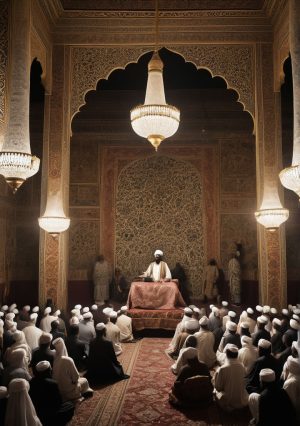
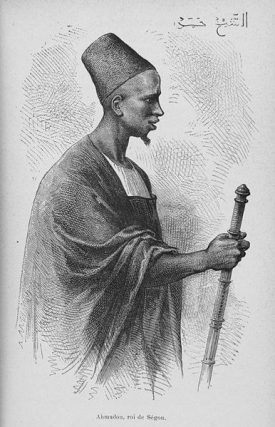
Sketch of El Hajj Umar Tall. Source: Wikimedia Commons
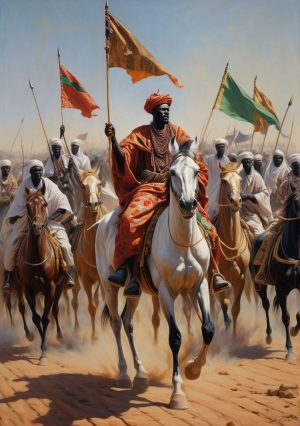
Tall died in February 1964, where some say he mysteriously disappeared into a cave in Bandiagara, Mali and never returned, whereas others say he died in battle.
- El-Hajj Malik Sy (1855-1922) created the Sy branch and built a zawiya in Tivaouane, Senegal in 1907. This center became a significant hub for Islamic learning, solidifying the Tijaniyya’s presence in modern day Senegal and Mali by drawing many disciples during the French colonial period. Today, Tivaouane in Senegal is highly visited by Sy followers, who seek blessings and pay respect to their shaykh.
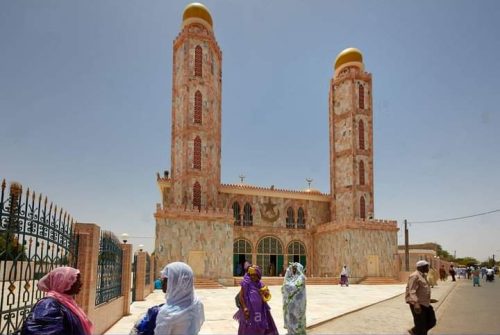
Zawiya Serigne Babacar SY. Source: @MrThread4, Twitter
- Ibrahim Niasse (1900-1975). One of the most influential tijani figures in this modern era, who established the Fayda Branch in Medina Baye, Senegal in the 1930’s. His love for the Tijaniyya order and establishment of the “fayda” concept attracts a large following throughout the world.
After taking leadership from his father Abdoulaye Niasse, who had also established a zawiya in Kaolack Senegal, Ibrahim Niasse argued that Tijani practices eventually lead to a direct experience of Allah’s presence. This concept is known as “fayda” (flood of spiritual blessing), which he believed was a special gift to Tijaniyya followers.
Under his guidance, the Kaolack zawiya became a major spiritual center, drawing thousands of disciples across the world. His work significantly expanded the order’s reach beyond Africa, making it one of the most influential spiritual movements in modern Islam.
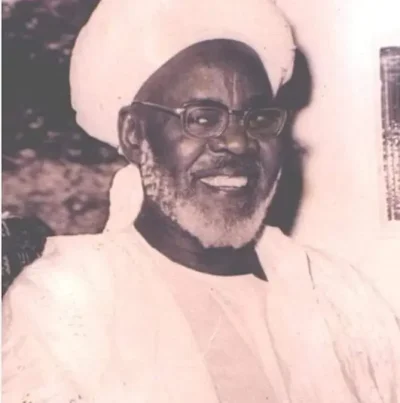
Shaykh Ibrahim Niasse. Source: Wikimedia Commons
Tijaniyya's Cultural Impact
The Tijaniyya Tariqa has had a significant cultural impact, particularly in countries like Senegal, Nigeria and Sudan. The tariqa has influenced religious practices as well as art, architecture and general social norms. Zawiyas established by the tariqa serve as community and religious tourism hubs, facilitating education, spiritual practice, and social services. The Tijaniyya has also played a role in shaping the political landscape in some regions by integrating Islamic principles into both community leadership and national governance.
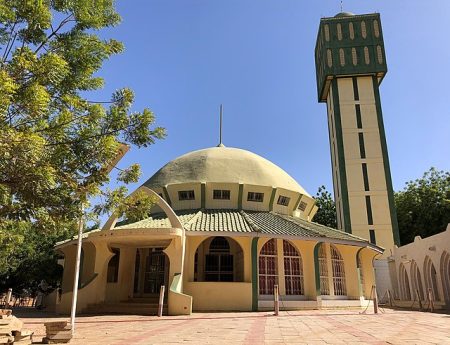
Tijaniyya Grand Mosque Kiota, Niger. Source: Wikimedia Commons
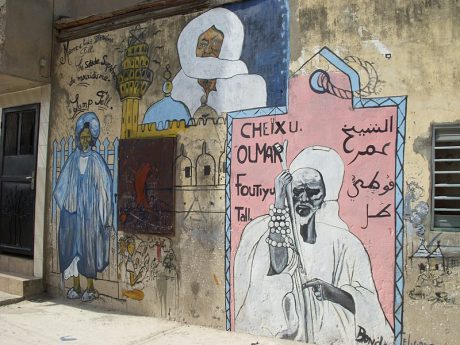
Street art showing Sufi leaders in Senegal. Source: Wikimedia Commons
In the age of globalization, the Tijaniyya has attracted followers worldwide, especially with the african diaspora in Europe and the US as well as the Black American community. Its universal messages of love, unity, and spiritual discipline appeal to people across various cultural backgrounds.
Tijaniyya Experience and Travel Recommendations
To truly experience the cultural impact of Tijaniyya, you can visit significant sites such as:
- Sidi Ahmed Al-Tijani Zawiya, Fez Morrocco: Located in the medina of Fez, a UNESCO World Heritage site, this zawiya attracts both Tijaniyya followers and secular tourists. Here, the order’s rich heritage and spiritual legacy come alive, offering a glimpse into the spiritual practices of the Tijaniyya.
- Medina Baye in Senegal: Where many tijani followers seek spiritual healing and pay respect within the resting place Shaykh Ibrahim Niasse. Sacred Footsteps, a spiritual travel publication shares in dept travel experiences at Medina Baye as well as other resources.
- Rumi Cave, London, UK. This diaspora community adopts Tijaniyya teachings and hosts regular community services, including soup kitchens and Tijani dhikr sessions. It serves as a vibrant center for spiritual and social activities, embodying the inclusive and community-focused spirit of the Tijaniyya.
For a visual experience, check out the YouTube channel “Let’s Talk Religion”. The channel host, Filip Holm accompanies Tijani followers on a pilgrimage to Zawiya Bogal led by Tijani Shaykh Abdulrahman Barry.
Conclusion
The Tijaniyya Tariqa is not just a religious path but a comprehensive spiritual and cultural system that has deeply influenced countless lives across the globe. Through its teachings, structured practices, and community-focused activities, the tariqa continues to foster a sense of spiritual fulfillment among followers.
For more insights into unique cultures, subscribe to my free newsletter below!

Do you mind if I quote a couple of your articles as long as I provide credit and sources back to your blog? My blog is in the very same niche as yours and my visitors would certainly benefit from some of the information you present here. Please let me know if this alright with you. Appreciate it!
Hello. Thanks so much for your feedback and apologies for the late response! Sure, happy for you to source my articles (with credit) so feel free to do so. Happy to have a read of your blog also!